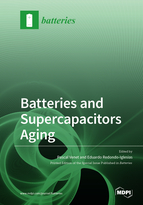Batteries and Supercapacitors Aging
A special issue of Batteries (ISSN 2313-0105).
Deadline for manuscript submissions: closed (31 December 2019) | Viewed by 142936
Special Issue Editors
Interests: characterization; modeling; reliability; aging and diagnosis of electric energy storage system (batteries, supercapacitors, capacitors)
Special Issues, Collections and Topics in MDPI journals
Interests: lithium-ion batteries; battery aging; battery characterization and modeling; electric vehicles; energy storage systems
Special Issues, Collections and Topics in MDPI journals
Special Issue Information
Dear Colleagues,
Electrochemical energy storage is a key element of systems in a wide range of sectors, such as electro-mobility, portable devices, or renewable energy. Energy storage systems (ESS) considered here are batteries, supercapacitors or hybrid components such lithium-ion capacitors. The durability of ESS determines the total cost of ownership and the global impacts (life cycle) on a large portion of these applications and thus their viability. Understanding of ESS aging is a key issue to optimize their design and usage towards their applications. Knowledge of the ESS aging is also essential to improve their dependability (reliability, availability, maintainability and safety).
In this Special Issue, we are looking for contributions helping to understand aging mechanisms, modes and factors, to perform ESS diagnosis and prognosis and innovative solutions to prolong their lifespans.
Topics of interest include, but are not limited to:
- innovative measurement techniques of ESS aging
- ESS aging modeling
- ESS state-of-health (SOH) estimation
- ESS prognostic and health management
- balancing circuits with consideration of the lifetime of ESS
- energy management laws taking into account aging
- influence of aging on cost and environmental analyses of ESS
- multi-objective optimization strategies of ESS including aging consideration
- optimal sizing and design of ESS
Prof. Dr. Pascal Venet
Dr. Eduardo Redondo-Iglesias
Guest Editors
Manuscript Submission Information
Manuscripts should be submitted online at www.mdpi.com by registering and logging in to this website. Once you are registered, click here to go to the submission form. Manuscripts can be submitted until the deadline. All submissions that pass pre-check are peer-reviewed. Accepted papers will be published continuously in the journal (as soon as accepted) and will be listed together on the special issue website. Research articles, review articles as well as short communications are invited. For planned papers, a title and short abstract (about 100 words) can be sent to the Editorial Office for announcement on this website.
Submitted manuscripts should not have been published previously, nor be under consideration for publication elsewhere (except conference proceedings papers). All manuscripts are thoroughly refereed through a single-blind peer-review process. A guide for authors and other relevant information for submission of manuscripts is available on the Instructions for Authors page. Batteries is an international peer-reviewed open access monthly journal published by MDPI.
Please visit the Instructions for Authors page before submitting a manuscript. The Article Processing Charge (APC) for publication in this open access journal is 2700 CHF (Swiss Francs). Submitted papers should be well formatted and use good English. Authors may use MDPI's English editing service prior to publication or during author revisions.
Keywords
- Aging mechanisms
- Aging modeling
- Component reliability
- Lifecycle assessment
- Lifetime prediction
- State of health
- Battery
- Supercapacitor
- Hybrid Capacitor







